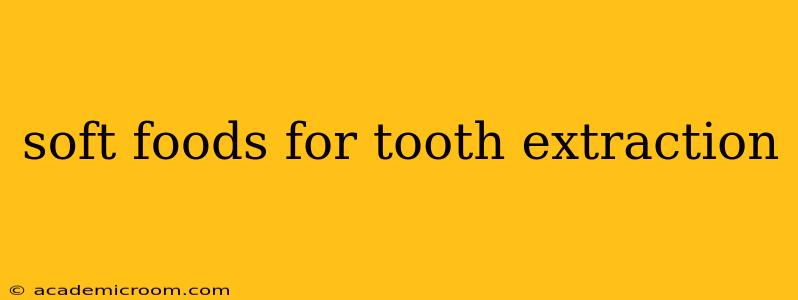Having a tooth extracted can be uncomfortable, and one of the biggest challenges is figuring out what to eat while your mouth heals. Choosing the right soft foods is crucial for promoting healing and minimizing pain. This guide explores ideal options and addresses common concerns.
What are the best soft foods after a tooth extraction?
The ideal soft foods after a tooth extraction are those that require minimal chewing, are easy to swallow, and are nutrient-rich to support your body's healing process. Think creamy, pureed, or easily mashed options. Avoid anything crunchy, hard, or sticky that could irritate the extraction site.
Some excellent choices include:
- Yogurt: Packed with protein and calcium, yogurt is a fantastic option. Choose plain varieties and add fruit for extra flavor.
- Applesauce: A classic choice, applesauce is smooth, easy to swallow, and provides fiber.
- Mashed Potatoes: A comforting and nutrient-rich option, especially when combined with broth for extra fluids.
- Scrambled Eggs: Easy to mash or blend for a smooth consistency, eggs provide essential protein.
- Oatmeal: Cooked oatmeal, especially with added fruit, is a good source of fiber and energy. Avoid crunchy toppings.
- Smoothies: Blend fruits, vegetables, and yogurt or milk for a nutrient-packed and easy-to-consume meal replacement.
- Soup: Broths, pureed soups (like cream of tomato or vegetable), and well-cooked lentil soups are excellent choices. Avoid soups with hard vegetables or noodles.
What foods should I avoid after a tooth extraction?
Avoiding certain foods is just as important as choosing the right ones. These are foods to steer clear of to prevent complications and promote faster healing:
- Hard Foods: Anything that requires significant chewing, like chips, nuts, pretzels, and raw vegetables, should be avoided.
- Sticky Foods: Candy, caramel, and gum can dislodge the blood clot forming at the extraction site, leading to a dry socket (a painful complication).
- Spicy Foods: Spicy foods can irritate the sensitive area and cause discomfort.
- Extremely Hot or Cold Foods: These can exacerbate pain and sensitivity. Let food cool down to a comfortable temperature before eating.
- Foods that Require Excessive Chewing: Even if a food is generally considered "soft," if it requires a lot of chewing, it’s best to avoid it until your mouth is more healed.
How long should I eat soft foods after a tooth extraction?
The duration you need to eat soft foods depends on several factors including the complexity of the extraction, individual healing rates, and your dentist's specific instructions. Generally, it's recommended to stick to soft foods for at least a week. Your dentist will provide personalized guidance during your post-operative consultation.
What if I get a dry socket?
A dry socket is a painful complication that occurs when the blood clot at the extraction site dislodges. This exposes the underlying bone and nerve endings. Symptoms include intense pain, a bad taste or odor, and a visible empty socket. If you suspect a dry socket, contact your dentist immediately. They can provide treatment to alleviate the pain and promote healing.
Can I eat anything crunchy or hard after a week?
After a week, you can gradually reintroduce some harder foods into your diet, but it's crucial to do so cautiously. Start with softer versions of your favorite foods and avoid anything overly crunchy or sticky. Pay attention to your body; if any food causes pain or discomfort, stop eating it immediately.
What are some easy recipes for soft foods?
Many simple recipes cater to soft food diets. A quick search online will reveal numerous ideas for pureed soups, mashed vegetable dishes, and creamy smoothies. Remember to prioritize nutrient-dense ingredients to support your healing process.
This guide provides general advice. Always follow your dentist's specific instructions for post-operative care. If you experience any significant pain, bleeding, or other complications, consult your dentist immediately. Remember, proper nutrition is key to a successful recovery after a tooth extraction.
